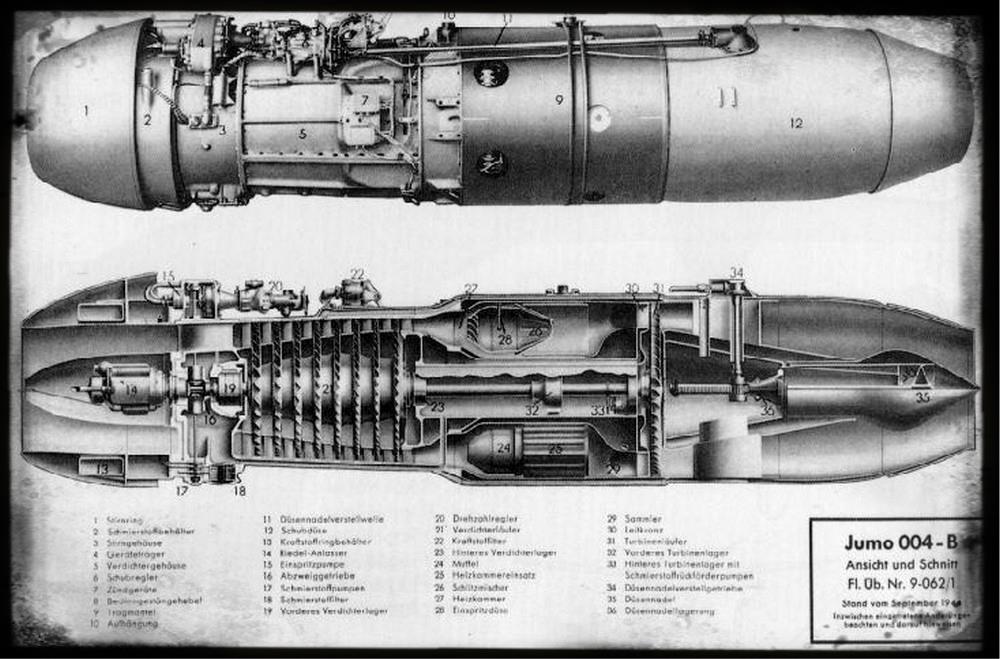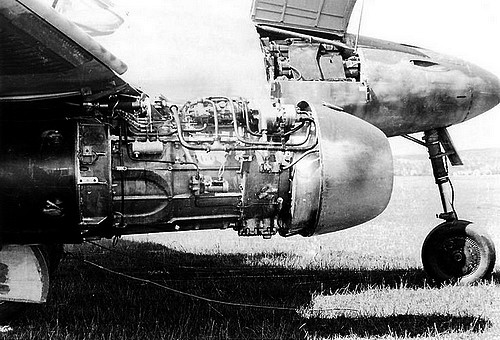Junkers Jumo 004
see also Junkers Jumo 004 Production / Junkers Jumo 004 Survivors / Junkers Jumo 004 Model Kits
Eight stage compressor, single stage turbine with axial flow, Diesel Oil 
The developement of the Jumo 004 was based on the Magdeburg experiments. This developement was continued by Franz Anselm at the Otto-Mader-Werke since 1939. Anselm used several existing components to built the Jumo 004. The compressor was built from an 8 stage axial construction of the AVA Gottingen. The turbine blades were developed by AEG.
On October, 11th 1940 the first static test run of the engine was performed. A total of 80 experimental Jumo 004A engines (V-series) were built. The designed 600kp thrust was first achieved on 6th August 1941. The first flight was performed on March, 15th 1942 onboard a Me 110 and on 18th July 1942 the first Messerschmitt Me 262 was equipped with the new engine at Leipheim during a 12 minutes test flight.
The first preproduction series was the Jumo 004A-0 (also called 109-004A-015). This engine was used for extensive flight tests, which did not satisfy due to material overload and failure of the fan blades. Also this test and experimental design was not usable for serial production as its material parts were rare and expensive.
In summer 1941 the reconstruction of the Jumo 004A for serial production was started. The first serial production engines Jumo 004B-1 to B-3 were ready in early 1942 and underwent intensive tests during 1943. The Jumo 004B differed in the compressor entry, an improved stator blade design for the compressor, modified turbine entry and had seperate compressor discs. Also hollow turbine blades were introduced, which caused again blade failures. In summer 1943 the serial production of these engines was started at Junkers Leipzig and at the Opelwerke at Russelsheim. The Messerschmitt Me 262 was mostly equipped with this engine. A total of 7916 Jumo 004B were built by Junkers Flugzeugwerke plus an unknown number of engines at Opel.
Several improved series were designed until the end of the war. The Jumo 004C had increased thrust, auxiliary fuel injection and afterburner. This series was only projected, none was built.
The Jumo 004D with regulator for throttle movement and two stage fuel injection. Prototypes were built and tested, serial production began shortly before end of WWII.
The Jumo 004E was D-series engine with a shorter tail pipe and a double tube. This engine was developed for getting a better altitude performance. At the end of WWII several test engines were ready and serial production was planned for summer 1945.
The Jumo 004H was a further developement, which also incorporated several features of the already designed Jumo 0012. It had an 11 stage axial compressor and a two stage turbine. This design did not leave project status until the end of WWII.
After WWII the Jumo 004 was still used by the Czech Air Force, which used the engine on the Avia S.91, which was originally the Messerschmitt Me 262 produced at Avia in Czechoslovakia during WWII. These Jumo 004 engines were produced at CKD at Prague.
The Russian forces captured several engines and documentation at Dessau. In Russia the Jumo 004 was used for further developement steps and finally ended in the Russian RD-10 Jet Engine, which was mounted on the YAK-15 and the La-150, as well as on several other Russian jet aircraft of the late 40s. The RD-10 had a slightly increased power of additional 50kg compared to the Jumo 004. Late RD-10 were also equipped with afterburner chambers. In Russia the RD-10 was built by UFA Engine Building Association in the Bashkortostan Republic in Ural.
In France the Jumo 004 was used in early 1945 for the initial French jet power designs, i.e. the Arsenal VG70.
Technical Data:
| Engine Designator | year | Compressor | Burner | Turbines | length in m | max diameter in m | Weight in kg | Max. Power in kN | r.p.m. |
|---|---|---|---|---|---|---|---|---|---|
| Jumo 004A Jumo 004B Jumo 004C Jumo 004D Jumo 004E Jumo 004H RD-10 (Soviet) RD-10A(Soviet) RD-10F (Soviet) | 1940 1942 1944 1944 1945 1945 1945 1947 1946 | 8 8 8 8 8 11 . . . | 1 1 1 1 1 1 . . . | 1 1 1 1 1 2 . . . | n.a. 3,864 3,864 3,864 3,864 n.a. . . . | n.a. 0,805 0,805 0,805 0,805 n.a. . . . | n.a. 750 735 745 n.a. 1200 . . . | 8 9 12,3 (?) 9 12 n.a. 910kg 1000kg 1100kg | n.a. 8700 8700 10000 n.a. 6600 . . . |
Aircraft Types equipped with Jumo 004:
Arado 234 B-series
The jet surveyer and bomber Arado Ar 234 was originally equipped with Jumo 004s.
The initial prototype Ar 234V1 flew first in June 1943 with a Jumo 004A engine
All prototypes except V6 and V8 (these got the BMW003A) were equipped with Jumo 004B-1 later.
A total of 210 aircraft of the initial production series Ar 234B were built and also equipped with Jumo 004B-1
The further improved C-series should be equipped with BMW003A-1.
But this series did not went into production until the end of WWII.
Blohm & Voss BV P.188
Another jet bomber aircraft was under development at Blohm & Voss.
This four engined BV P.188 was designed with four Jumo 004C engines.
The project was stopped before the end of WWII.
Gotha Go 229
The wing only fighter Go 229 was a further improvement of the Horten Ho IX.
This aircraft should be equipped with two Jumo 004B.
A prototype was under construction in May 1945
and was later transfered to the USA.
Gotha P.60B
A further improved Go 229 was under design as P.60 at Gotha.
While the P.60A was designed with two BMW003,
the P.60B should be equipped with Heinkel He S11 or Jumo 004C.
Heinkel He 280
The Heinkel jet fighter He 280 was designed for Jumo 004 or BMW engines.
The He 280V2 was the first aircraft of this type to be equipped with two Jumo 004.
Several sources speak of up to 4 prototypes, which should be built with Jumo 004 engines,
but other sources also speak of only three prototypes built in total.
Nevertheless, the He 280B series was intended to be equipped with Jumo 004
as the standard engine, but finally the He280 programm was stopped
before the production was started.
Horten Ho IX
The wing only fighter aircraft Horten Ho IX was designed with two Jumo 004Bs.
The prototype flew first in March 1944. The second prototype crashed
in February 1945 after turbine failure. Serial production of the Ho IX was
prepared at Gotha as Go 229. But no aircraft was completed until the end of the war.
Junkers Ju 287
The experimental jet bomber Ju 287 was equipped with four Jumo 004B-1.
Only a single prototype was built until the end of WWII. A second prototype was under construction.
Messerschmitt Me 109TL
An alternate proposal for the Me 262 saw a Messerschmitt Me 109
equipped with two Jumo 004B engines. This idea was dropped
as the structure of the Me 109 needed radical changes.
Messerschmitt Me 110
A Messerschmitt Me 110 was used for the first inflight tests of the Jumo 004A.
In the end of 1941 a first flight with prop support was performed,
while the first flight without prop support was performed on March, 15th 1942.
Messerschmitt Me 262, Avia S-92
The first Me 262V1 flew first on April, 18th 1941 with a Jumo 210G propeller engine. V1 and V2 were later equipped with BMW003 engines. The V3 was the first Me 262, which got the Jumo 004A-0 engine. It flew first on Juky, 18th 1942. It was followed by V4 to V6, also equipped with Jumo 004As Me 262V7 to V12 were already equipped with the serial production engine Jumo 004B-0. This engine became the later serial production engine for the Me 262. The initial production fighter aircraft Me 262A0, A1 and the B1 got the Jumo 004B-1, while the bomber series Me 262A2 and the night fighter Me 262B2 were later equipped with Jumo 004B-3. The fighter version Me262C-1 should also be equipped, but a C-2 series was designed with BMW003R also. A total of 1433 aircraft were built, most equipped with Jumo 004 engines.

Yakolev YAK-15, YAK-17 (post WWII RD-10)
The Russians further developed the Jumo 004 after WWII as the RD-10.
This engine was initially used for the YAK-15. Also YAK-17 was equipped with this engine.
Lawotschkin La-150, La-152, La-156, La-16ß (post WWII RD-10)
In 1945 the OKB Lawotschin was asked for a jet fighter aircraft developement,
from which the LA-150 resulted. This aircraft used the RD-10 power plant.
A total of 15 La-150 with RD-10 engines were built until 1948.
Futher developements of the La-150 were also equipped with the RD-10.
Sukhoi Su-9 (post WWII RD-10)
At Sukhoi a copy of the Messerschmitt Me262 was developed as the Su-9
The RD-10 was used on that copy as well, when it flew first in Aug. 1946.
Arsenal VG-70
The Arsenal VG-70 was an initial French jet aircraft design,
which used some Jumo 004, which were found in France after WWII.
However, the design was not successfull, as it was underpowered.
Sud-Ouest S.O. 6000 Triton
The Triton developement started in 1944 and saw a Rateau SRA-1 jet engine.
But, when the Triton prototype was ready for flight, this engine still was
not reliable enough. Therefore the prototype was equipped with a Jumo 004-B2
and performed its first flight in November 1946. In sofar the first French
jet powered aircraft was equipped (temporarily) with a Jumo 004.
Weblinks:
- AllWorldWars.com - Jumo 004 Combustor Performance Investigation Report
Literature:
- Cyrus B. Meher-Homji
The Development of the Junkers Jumo 004B
American Society of Mechanical Engineers, 1996, Download PDF here
introduced Nov 1996, transfered Aug 2017
http://hugojunkers.bplaced.net/
contents last updated 28 Dec 2003

